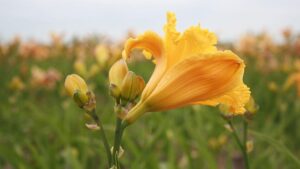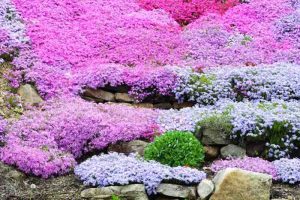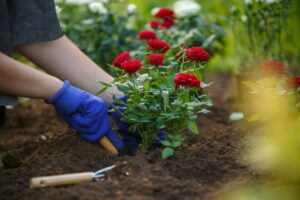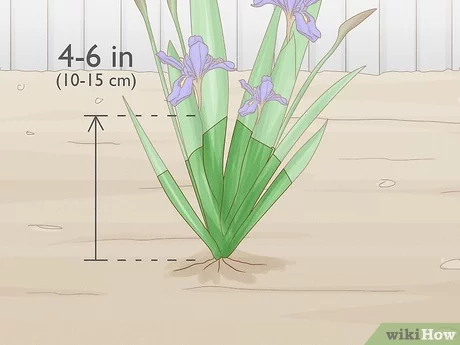Yellow Daylilies: A Beacon of Sunshine in Your Garden
The bright yellow petals of a daylily are a welcome sight in any garden, bringing a touch of sunshine to even the darkest of days. Daylilies are also relatively easy to grow, making them a great choice for gardeners of all skill levels.
This article will provide you with everything you need to know about growing yellow daylilies, from choosing the right variety to caring for your plants. So if you’re looking for a low-maintenance flower that will add a splash of color to your garden, read on!

Choosing the Right Yellow Daylily
Choosing the Right Yellow Daylily
When choosing a yellow daylily, there are a few factors to consider.
- Size: Yellow daylilies come in a variety of sizes, from miniature varieties that only reach a few inches tall to large varieties that can grow up to 3 feet tall. Consider the amount of space you have available and choose a variety that will fit comfortably in your garden.
- Bloom time: Yellow daylilies bloom from early summer to late fall, with some varieties blooming for longer than others. Choose a variety that will bloom during the time of year that you want to enjoy them most.
- Hardiness zone: Yellow daylilies are hardy in zones 3-9, so you can grow them in most parts of the country. However, some varieties are more cold-hardy than others, so it’s important to choose a variety that is suitable for your climate.
- Disease resistance: Yellow daylilies are generally resistant to pests and diseases, but some varieties are more susceptible than others. If you live in an area with a lot of pests or diseases, choose a variety that is resistant to the most common problems.
Once you’ve considered these factors, you can start choosing the right yellow daylily for your garden. Here are a few of our favorites:
- Hemerocallis ’Stella d’Oro’: This miniature daylily is a popular choice for its bright yellow flowers and compact size. It blooms from early summer to late fall and is hardy in zones 3-9.
- Hemerocallis ’Happy Returns’: This large daylily is known for its long-lasting flowers. It blooms from late spring to early fall and is hardy in zones 4-9.
- Hemerocallis ‘Golden Chimes’: This daylily is a great choice for its fragrant flowers. It blooms from early summer to late fall and is hardy in zones 4-9.
With so many beautiful yellow daylilies to choose from, you’re sure to find one that’s perfect for your garden.
Planting and Caring for Your Yellow Daylily
Planting and Caring for Your Yellow Daylily
Yellow daylilies are a popular choice for gardeners because they are easy to grow and care for. They are also very beautiful, with large, showy flowers that bloom in a variety of shades of yellow.
Planting
Yellow daylilies can be planted in the spring or fall. They prefer full sun, but will tolerate partial shade. They also do well in a variety of soil types, but they prefer well-drained soil.
When planting yellow daylilies, dig a hole that is twice the width and depth of the root ball. Place the root ball in the hole and fill it with soil. Water the plant well after planting.
Caring for
Yellow daylilies are relatively low-maintenance plants. They only need to be watered regularly during dry periods. They also benefit from being fertilized once a year in the spring.
Yellow daylilies are not susceptible to many pests or diseases. However, they can be affected by aphids, slugs, and snails. If you notice any pests on your plants, you can treat them with a natural insecticide or insecticidal soap.
Harvesting
Yellow daylilies can be harvested when the flowers are fully open. To harvest the flowers, simply cut them off the stem with a sharp knife or scissors. The flowers can be used fresh in arrangements or dried for later use.
Tips for Success
Here are a few tips for growing successful yellow daylilies:
- Choose a sunny location with well-drained soil.
- Water the plants regularly during dry periods.
- Fertilize the plants once a year in the spring.
- Inspect the plants regularly for pests and diseases and treat them as needed.
- Harvest the flowers when they are fully open.
With a little care, you can enjoy beautiful yellow daylilies in your garden for many years to come.
Troubleshooting Yellow Daylily Problems
Troubleshooting Yellow Daylily Problems
Yellow daylilies are a popular choice for gardens, but they can be susceptible to a variety of problems. Here are a few common problems and how to troubleshoot them:
- Wilting leaves: If your yellow daylilies are wilting, it could be due to a number of factors, including:
- Too much water: Yellow daylilies do not like to be overwatered. Make sure to water them only when the soil is dry to the touch.
- Too little water: Yellow daylilies also do not like to be underwatered. Make sure to water them regularly, especially during hot and dry weather.
- Root rot: Root rot is a fungal disease that can cause yellow daylilies to wilt. If you suspect that your yellow daylilies have root rot, you can treat them with a fungicide.
- Brown leaves: Brown leaves on yellow daylilies can be caused by a number of factors, including:
- Sunburn: Yellow daylilies can be susceptible to sunburn, especially if they are planted in full sun. If you think your yellow daylilies are sunburned, you can move them to a location with more shade.
- Insect damage: Insects such as aphids, leafhoppers, and mites can all damage yellow daylilies, causing their leaves to turn brown. If you suspect that your yellow daylilies are being damaged by insects, you can treat them with an insecticide.
- Disease: Diseases such as powdery mildew and rust can also cause yellow daylilies to develop brown leaves. If you suspect that your yellow daylilies have a disease, you can treat them with a fungicide.
By following these tips, you can help troubleshoot common yellow daylily problems and keep your plants healthy and beautiful.
Table of Contents
- Wilting leaves
- Brown leaves
- Sunburn
- Insect damage
- Disease
Growing Yellow Daylilies for Cutting
Growing Yellow Daylilies for Cutting
Yellow daylilies are a popular choice for cutting gardens because they are easy to grow and produce a large number of blooms. Here are a few tips for growing yellow daylilies for cutting:
- Choose a sunny location with well-drained soil. Daylilies are drought-tolerant plants, but they will produce more blooms if they are watered regularly.
- Fertilize your daylilies with a balanced fertilizer once a month during the growing season.
- Deadhead spent blooms to encourage more flowers.
- Divide your daylilies every few years to keep them healthy and vigorous.
Yellow daylilies are a beautiful addition to any cutting garden. They are long-lasting and make a great addition to bouquets and arrangements.
Table of Contents
- How to Grow Yellow Daylilies
- Tips for Growing Yellow Daylilies for Cutting
- Troubleshooting Yellow Daylilies
How to Grow Yellow Daylilies
Yellow daylilies are easy to grow from seed or from divisions. Here are the steps involved in growing yellow daylilies from seed:
- Sow the seeds in a seed tray filled with a sterile potting mix.
- Cover the seeds with a thin layer of potting mix.
- Place the seed tray in a warm location with bright indirect light.
- Water the seed tray regularly.
- Germination should occur within 2-4 weeks.
- Transplant the seedlings into individual pots when they are large enough to handle.
- Grow the seedlings in a sunny location until they are ready to be transplanted into the garden.
Here are the steps involved in growing yellow daylilies from divisions:
- Dig up a mature daylily plant in the fall.
- Use a sharp knife or spade to divide the plant into several sections.
- Each section should have at least 2-3 healthy roots and a few leaves.
- Replant the divisions in a sunny location with well-drained soil.
- Water the divisions regularly.
- The divisions should begin to produce new growth in the spring.
Tips for Growing Yellow Daylilies for Cutting
Here are a few tips for growing yellow daylilies for cutting:
- Choose a sunny location with well-drained soil.
- Fertilize your daylilies with a balanced fertilizer once a month during the growing season.
- Deadhead spent blooms to encourage more flowers.
- Divide your daylilies every few years to keep them healthy and vigorous.
- Cut the flowers when they are fully open.
- Store the flowers in a cool, dry place until you are ready to use them.
Troubleshooting Yellow Daylilies
If your yellow daylilies are not blooming, there are a few things you can check:
- Make sure the plants are getting enough sunlight.
- Fertilize the plants with a balanced fertilizer once a month during the growing season.
- Water the plants regularly.
- Divide the plants every few years to keep them healthy and vigorous.
If your yellow daylilies are wilting, there are a few things you can check:
- Make sure the plants are getting enough water.
- Check the soil pH and adjust it if necessary.
- Water the plants with a fungicide to prevent fungal diseases.
If your yellow daylilies are infested with pests, there are a few things you can do:
- Spray the plants with an insecticide to kill the pests.
- Hand-pick the pests off the plants.
- Use a biological control, such as ladybugs or lacewings, to help control the pests.
Attracting Butterflies with Yellow Daylilies
Attracting Butterflies with Yellow Daylilies
Yellow daylilies are a beautiful addition to any garden, and they can also help attract butterflies. Butterflies are attracted to the nectar of daylilies, and they can also use the flowers as a place to lay their eggs. If you want to attract butterflies to your garden, consider planting some yellow daylilies.
Here are a few tips for attracting butterflies with yellow daylilies:
- Choose a variety of daylilies that bloom at different times of the season. This will help ensure that there is always nectar available for butterflies.
- Plant daylilies in a sunny location. Butterflies need sunlight to warm their bodies and help them fly.
- Water your daylilies regularly. Butterflies need water to survive, and they will be more likely to visit your garden if the plants are well-watered.
- Avoid using pesticides in your garden. Pesticides can kill butterflies and other pollinators.
If you follow these tips, you’ll be sure to attract butterflies to your garden. And with a little luck, you might even see some of them laying eggs on your daylilies.
Table of Contents
What Attracts Butterflies?
Butterflies are attracted to a variety of things, including flowers, nectar, water, and sunlight. They are also attracted to certain colors, such as yellow, orange, and red. If you want to attract butterflies to your garden, you can try planting flowers that are known to attract butterflies, such as daylilies, coneflowers, and zinnias. You can also provide a source of water for butterflies, such as a birdbath or a shallow dish of water. And you can make sure that your garden is in a sunny location.
How to Attract Butterflies
Here are a few tips for attracting butterflies to your garden:
- Plant flowers that are known to attract butterflies, such as daylilies, coneflowers, and zinnias.
- Provide a source of water for butterflies, such as a birdbath or a shallow dish of water.
- Make sure that your garden is in a sunny location.
- Avoid using pesticides in your garden.
- Keep your garden free of weeds and debris.
- Inspect your plants regularly for signs of pests and diseases.
- If you see a butterfly laying eggs on your plants, leave the eggs alone. The butterflies will hatch and help to pollinate your plants.
Benefits of Attracting Butterflies
There are many benefits to attracting butterflies to your garden.
They are also important pollinators, which means that they help to spread pollen from flower to flower. This helps to ensure that plants are able to reproduce and produce fruit. Butterflies can also help to control pests in your garden. They eat aphids, caterpillars, and other insects that can damage your plants.Butterflies are beautiful creatures that can add a lot of interest and beauty to your outdoor space..
attracting butterflies to your garden is a great way to improve the beauty and health of your outdoor space. It is also a great way to help the environment.
Growing Yellow Daylilies in a Container
Growing Yellow Daylilies in a Container
Yellow daylilies are a beautiful addition to any garden, and they can also be grown successfully in containers. Here are a few tips for growing yellow daylilies in a container:
- Choose a container that is at least 12 inches deep and wide. Yellow daylilies have deep roots, so they need a container that will give them plenty of room to grow.
- Fill the container with a well-draining potting mix. Yellow daylilies do not like to sit in wet soil, so make sure the potting mix you use is well-draining.
- Plant your yellow daylilies in the spring or early summer. This will give them plenty of time to establish themselves before the first frost.
- Water your yellow daylilies regularly, but do not overwater them. Yellow daylilies need to be watered regularly, but they should not be overwatered.
- Fertilize your yellow daylilies monthly with a water-soluble fertilizer. Yellow daylilies need to be fertilized regularly to produce blooms.
- Deadhead your yellow daylilies regularly. Deadheading will encourage your yellow daylilies to produce more blooms.
By following these tips, you can successfully grow yellow daylilies in a container.
Table of Contents
- Choosing a Container
- Filling the Container
- Planting Your Yellow Daylilies
- Watering Your Yellow Daylilies
- Fertilizing Your Yellow Daylilies
- Deadheading Your Yellow Daylilies
Resources
This website from the University of California Master Gardeners provides a wealth of information on growing daylilies, including tips on choosing the right variety, planting and caring for your plants, and dealing with pests and diseases.
2. The American Daylily Society
The American Daylily Society is a non-profit organization dedicated to the promotion of daylilies. Their website includes a variety of resources for daylily growers, including a database of daylily cultivars, a forum for discussion, and a calendar of events.
In Retrospect
Outro
Yellow daylilies are a beautiful addition to any garden, and they’re relatively easy to grow. With a little care, you can enjoy these cheerful flowers for many years to come.
So what are you waiting for? Start growing some yellow daylilies today!
- Visit your local nursery or garden center to find the perfect yellow daylily for your garden.
- Read more about growing daylilies to learn more about how to care for them.
- Share this article with your friends and family so they can learn about the joys of growing yellow daylilies too.
- Cat Palm vs Majesty Palm: Which Should You Choose? - June 30, 2024
- Flowers That Survive Winter: Discover the Exceptional No. 5 - June 30, 2024
- The Ultimate Guide to the Growth and Care of the Black Pagoda Lipstick Plant - June 29, 2024





